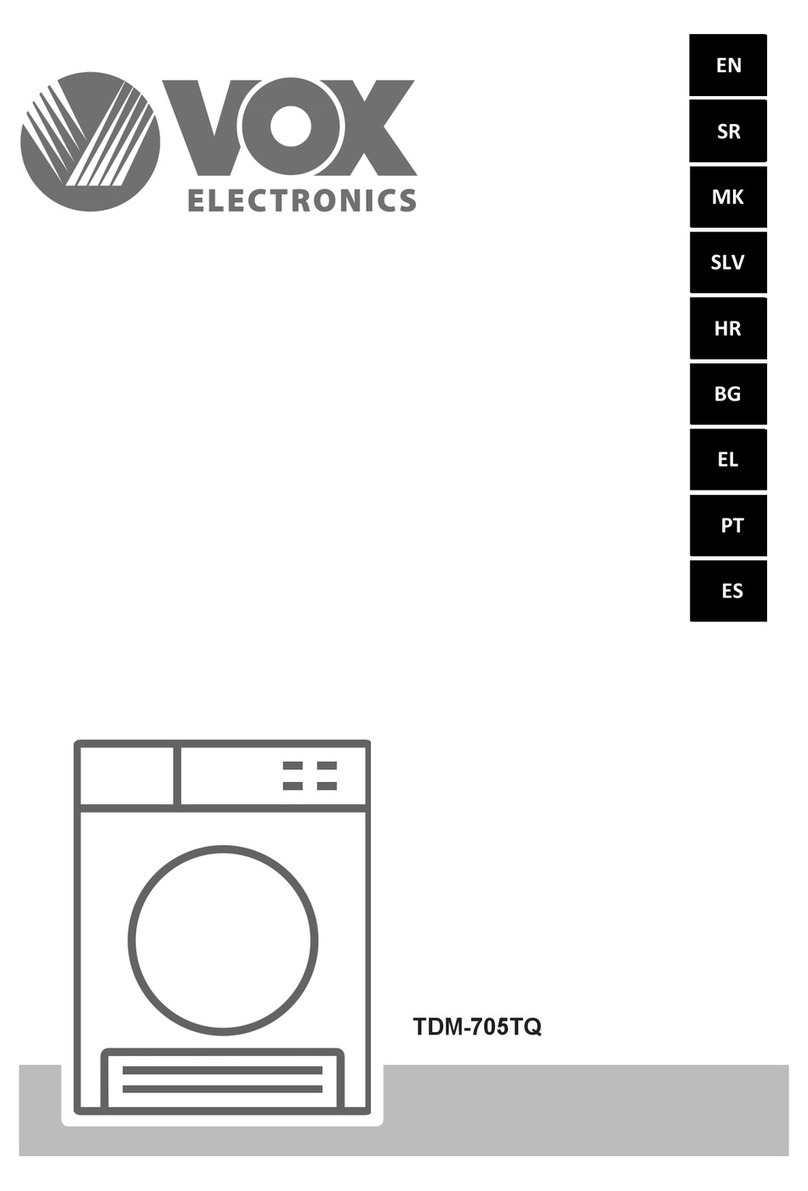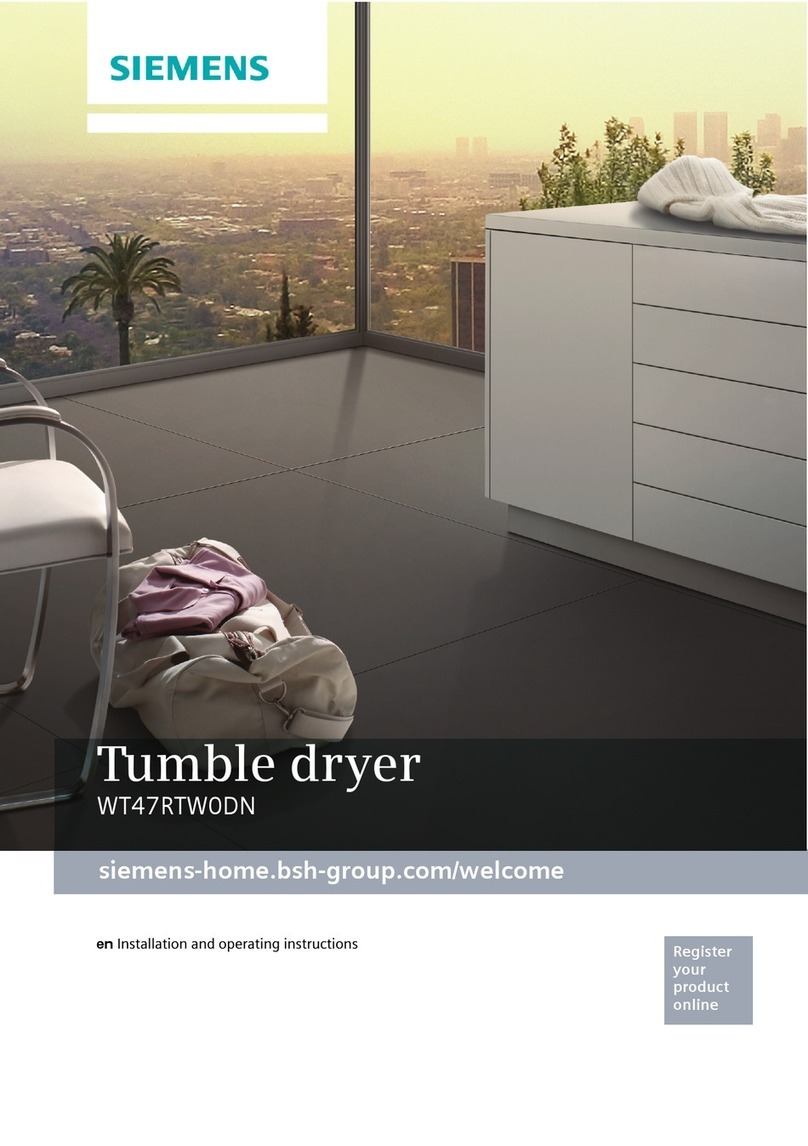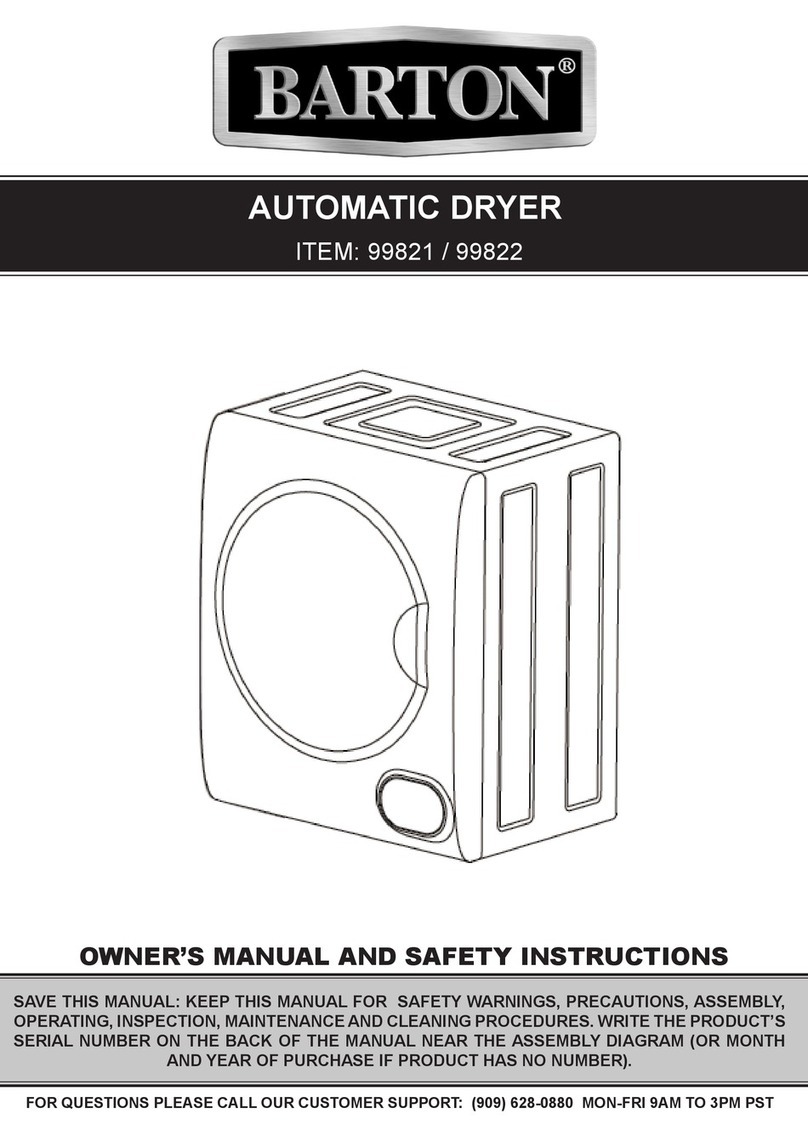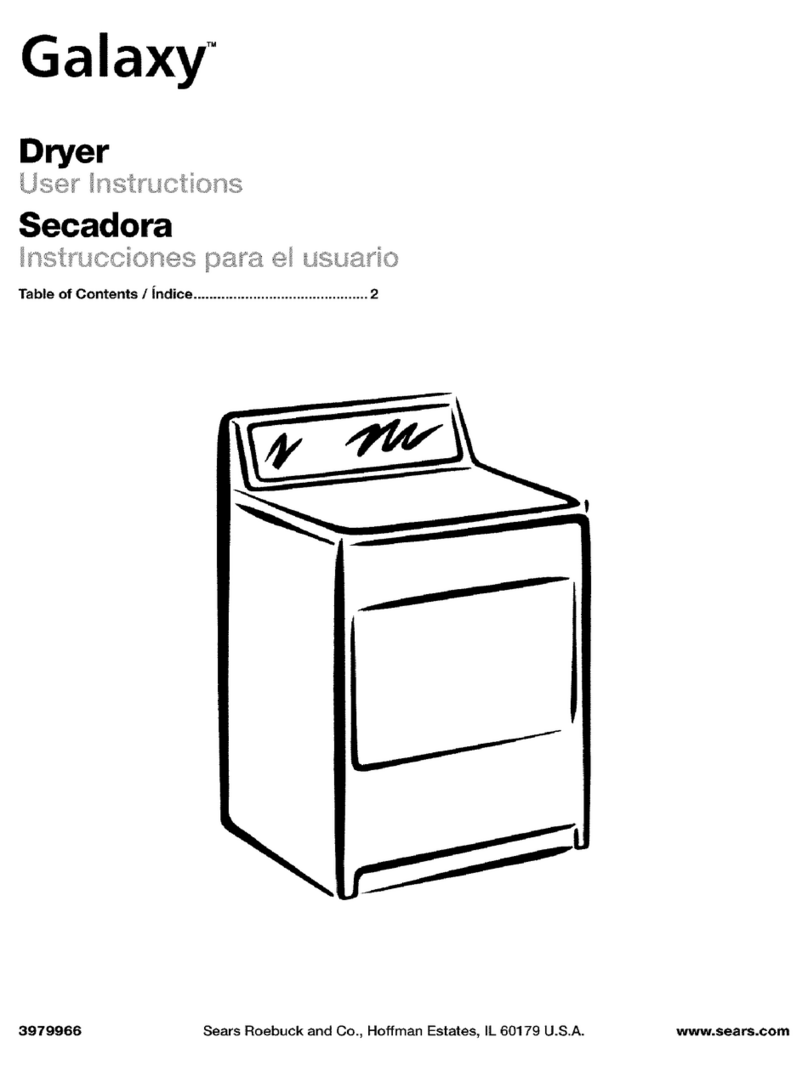Sears C260-62100 Operating and installation instructions

II
fl srurcoxs
DCATS
rl
De,partment 731.4.
Tbronto
TECHNICAL FLASH
T.F. 26-23
ApriL 7, 1983
SEF?VICE INFORMATINN
*^
CGNMPACT
P(}&TAtsLE I}RYffiffi
c26(}- 6@g(}(}
'.*

T.F. 26-23
INDEX
PAGE
I General
. . . .
. .
. . . . . . . . . . . . . . . ' . . . . .l
II Specifications............... .....2
III BasicOperation....o...o..........3
IV Disassembly. .
. . . . . . ..
. . . .. .. .. ..
. .4
V Trouble
Shooting..................18

-1- T.F. 26-23
SERVICE INSTRUCTIONS
COMPACT
PORTABLEDRYER
I. GENERAL
This is a portable electric dryer designed to oPerate efficiently on
I20 volts, 60 hertz.
It is equipped with a Ehree-wire cord for use in a grounded receptacle.
THE UNTT MUST BE GROUNDED!
Although noE necessary for operation, it would be advantageous, as with
any dryer, to vent this unit to the outside whenever and wherever
possible for maximum
efficiency. (See specification section).
The reset button must be pushed to re-start the dryer each time the
door is opened and closed.
The rear panel must be rercved for urost servicing except to re-position
a displaced drive belt, or idler pulley and spring.
The timer controls drying time. Ttte brown area of the dial is heat,
except the last 7 minutes of the cycle, which is a cool-down period.
The orange area of the dial is air (no heat) only.
the unit will not run with the door oPen. l{hen the door is closed,
it pushes in the switch shaft (Pig. I), however, the door switch is
not yet activated.
When the reset button is
depressed, it turns the
switch shaft to activate
the door switch.
Drying tsime depends on size
and type of load, suffi-
cient voltage, and an
adequate air supply, both
intake and exhaust.
For efficient operation,
the dryer should be
operated on a circuit of
its own, and extension
cords or other similar
devices should not be used.

rr. SPECIqrgaT-IoNS.
Size
Weight
Drum Diameter
Drum DePth
Drum Speed
Element
Motor Rating
Drum Drive
Blower Drive
-2- T.F. 26-23
31" high, 16" deep, 24" wide
84 Ibs.
zL-I/2"
12-3/8"
56-58 R.P.M.
12OO
Watt (17 Gauge Nichrome Wire)
4 Anps
Poly-vee belt off of motor
Direct off of motor
Horsepower I/6 "\--
Hi-Limit Thermostat 2000
Cycling Thermostat L250
External Venting (te Used) S" pipe, 12' maximun length:
2-9Oo elbows maximum
Lint Filter Location fnside drum--rear centre

-3- T.F. 26-23
\III. BASIC OPERATTON
CUT.tsffiY
UIEH
(,FHtl(lUER
DffYEN
stxEstc
g,fttrfis
T}€RilOStAI
lHr
rjflrTl
HETilt8
AIHAfi
rpoR
ffilrsrAT
lcofinuj
mr nile
tntfl
l illsrm
rx,cT
TXHAUST
FIG. 2
When the motor is energized, the drum rotaCes and the blower starts.
Air is drawn in through the rear panel rouvers, top and bottom, across
the heating elerent and into the drum. All air must then pass through
the lint filter, down and out the exhaust duct.
NCIE: A clogged lint filter or exhaust system will decrease air flow
and increase drying time. The filter should be cleaned after each load
is dried.
al
f,
rl
,1,
-\
=-\
7
:?

-4-
DISASSEMBLY
BE SURE
THE UNIT IS UNPLUGGED
A. Rear Panel Assembly
The rear panel assembly includes fan housing, cycling thermostat,
rear drum bearings, felt seal, hole plugs, ground strap, attachment
cord and exhaust deflector'
The rear panel secures the drum in position, therefore, when the
panel is removed, the drum is loose.
Hole Plugs
Exhaus
t
De
fIec
tor
OUTS
IDE
-At Eachmen
t
Cord
TNS
IDE
FIG. 3
To Remove
Lay the dryer on its front. Be sure to block the top edge
with a block of wood or box to prevent damage to the timer knob.
Remove the fourbeen (f4) L" hex head screws which secure the
panel to the shell. NOTE: A grounding washer is under one screr".
Be sure this washer is replaced and under the same screw. This
washer insures continuity between the sheII and grounded rear
panel.
T.F. 26-23
IV.
Beartngs
Fan Houslng
Felt Seal
Cyc.1.1ng
Thermos
cat

-5-
Lift the rear panel up only clear of
FIG. 4
T.F.26-23
the drum and
Rear Panel
I
I
fan (Fig.4l
Reach in and seParate the
The rear panel can now be
wiring harness
renroved.
aE the multiple connector.
REC€PTACL€
HOUSING
TA8 ITOUSING
MULTIPLE
CONNECTOR
Mulciple
ConnecEor
FIG.5

-6-
Ground StraP
The Ground strap is located in the rear duct. It bleeds off any
static charge in the drum. If the spring tension is gone or
the blade is worn, replace the ground strap using blind rivets.
Lr:bricate the strap with a light coat of specified silicone grease
prior to re-assenbly.
Attachment Cord
If the cord must be replaced, the multiple connector will have to
be removed and the ground wire disconnected frorn inside of the
rear panel.
The cord wires lock into the multiple connector and if forced out,
destroy the lock, creating an electrical hazard.
Therefore, when replacing wires in the multiple connector, cut
the connector at every wire to free the terminals. Use a nehr
connector. Use a good crimp on any terminal replaced. Push the
terminal into the connector and it will lock into position.
Felt Heat Seal
Grasp at any point and work seal off. The seal is held by an
adhesive around the entire mounting surface. Wtrenreplacing seal,
clean off all old adhesive and then attach new seal with 3M-1300.
Therrnostat
This section covers both the control thermostat located in the
fan housing and hi-limit thermostat located on top of the heat
shroud.
The hi-Iimit thermostat is rated at 2000. The cycling thermostat
is rated at 1250. The rating is stanped on the thermostat for
indentification.
ftre hi-Iimit thermostat will open with the failure of the cycling
thermostat or any interruption of air flow such as a lint clog'
broken fan or worn felt seals. lltre cycling thermostat controls the
drying temperature in the drun.
Testing
The thermostats cannot be electrically tested with the unit
running. If the heat cycle will not operate' a test can be
taken with an ohm meter across the terminals. A complete
T.F. 26-23
1.
2.
3.
4.

-7- T.F. 26-23
circuit tends to indicate a good thermostat electrically.
Hovtever, after attaching ohm meter leads to the thermostat
terminals, the terminaLs should be moved to check for inter-
mittent contact. If the condition of the thermostat is
questionable, after testing, it should be replaced.
In addition to a continuity test, the operating temperature
may have to be checked.
A temperature test can be made i.lith a stem thermometer in the
lower plug hole or an oven thermometer in the rear exhaust
duct. The temperature will vary from l5Oo to ltOo on cycles.
This would verify the cycling thermostat.
After the cycling therrostat is verified, the hi-linit
thermostat can be checked in the same method by jumping
the cycling therrnstat.
Another test of the hi-Iimit therrnostat is to run the unit
with the door open and the door switch depressed. If the
hi-Iimit thermostat cuts out the heat circuit, it is
serving its purpose.
Thermostats are subject to temperature variance, therefore,
a temperature test rnay be required to verify normal operation.
5. Molded Fan Housing
Secured by eight 5,/L6" hex head screws located on the outside of
the rear panel. NOTE: One hole plug will have to be removed
from the rear ducF6 make one screvt accessible.
6. Drum Bearings
This section covers replacement of both front and rear drum bearings
located in the heat shroud and rear duct, respectively.
NOTE: Lubrication for drum bearings is applied to the drum
G-nges before re-installing it into the unit.
1. Clean aII existing grease from the front and rear drum flanges.
2. Clean flanges with fine grade (250-400) emery cloth or sandpaper
to insure they are free of foreign matter, then wipe clean.
3. Be sure inside of drum is clean.
4. Apply a thin coat of Silicone Grease (GE G-34I-M) to each drum
flange.

T.F
. 26-23'
-8-
To replace bearings:
I. Remove
the bearing(s) to be replaced from the flange.
2. Removeall old adhesive and felt from the flange with a
non-flammable solvent. Be sure the flange surface is
clean and drv.
3. Use 3I"t
#847 Adhesive to attach new bearing blocks to the
flanges.
4. Apply a thin coat of adhesive to the entire felt surface
of the bearing where it contacts the flange.
Rear: Install blocks on flange of the rear panel, flush
dff,- tne inside edge. A 4" wide putty knife or metal lrlate can
be used as a guide to assure that the bearing blocks are
motrnted flush.
Bearing Block
Felt SeaI
FTG. 6
Position one block in upper centre^of rear duct, and two (2')
blocks in lower half on centre, 45" off of bottom centre. To
determine this, place one block (no adhesive) on bottom centre,
then mark the flange approximately l" from each end of this block.
These marks are the position of the bottom edges of the two (2)
lower blocks when installed.
Bearing
Flange
t

-9- T.F. 26-23
tdler RoIler
rnst.arr the new bearing and clarnp* securely in the centre.
Allow a minimum of 30 min,rrefE dry@
installing the drum. Do not. st@
eight (B) hours.
NOTE: IDL BINDER
CLIP* p3-2O-2O.
is one suggested c)-amp.
ores.
Front: Refer
blocks to the
front panel.
Posit,ion one
three blocks;
bolt; and one
above).
BeIt
to preceding steps I-4, then: Install bearing
flange of the heat shroud with edge against t.he
Refer t.o Fig. 15.
(I) block in upper cent,re of heat shroud and
one in lower half; one centred over each shroud
on bottom centre. (Adhesive setting time: see
B.
l.
2.
If off of the idler pulley. it can be re-positioned by
removing the access panel rocated on the bottom of the
unit. Viewing the dryer from the front, lay it on its
reft side - Remove tne uoGilnel and work t.hrough che
opening- (Fig. 7 shows bert position after instarlation).
ff broken, the rear panel wilt have to be removed. See
Section Iv, A, for panel removal. Be sure idler spring is
hooked into the shell near the access panel.
To install:
a. Place belt over drum with
ribbed portion of belt
next to drum, and hold
belt taut.
b. Place belt over motor
pulley white stitl holding
taut to keep it on the
drum-
c. Lift the idler roller up
past the belt, putting
tension on the spring,
and place the belt over
the roller and release
the roller slowly so
that tension will be
maintained on the beIt.
(See rig. 71. This is
the position of the belt
and idler after assembly.
PuIley
Belc
er Sg
DrrJm
Spring
Outer Shell
Idler
FIG.7

-10- T.F. 26-23
Drum
Removethe rear panel and drive belt, then lift the drum straiqht
out from the shelI.
Filter Guard Assembly
The filter guard, inside the drum, rear centre, is removed
by grasping in the finger holes provided and pulling straight
out. NOTE: A bead around that portion of the fiLter guard
which ?iE into the drum and four (4) dimples in the rear
portion of the drum keep the guard from falling out. When
installing, the guard should snap into place with a positive
click.
Lint Filter
The filter itself is inside the filEer guard. With the
filter guard in one hand, screen mesh portion facing you,
notice a "handle" on the filter itself. Grasp handle and
rotate filter so that it is adjacent to any one of four (4)
securing Eabs of the filter guard. pull the ',handIe,,
away from the tab and straight out. To replace, place
filter in guard and push into place around the entire 3600
circumference or until the filter "cricks" past arl four tabs.
FTG. 8
D. Outer Shell Assembly
The shell assembly includes:
(f) Motor Assembly, (2) Idler Assenbly, (3) Bottom Access panel,
(41 Clips which secure wiring, and (5) wheels.
The rear panel must be removed to service all but the wheels and
the boEtom access panel
I.
2.

-11- T.F.26-23
l. Motor Assembly
General: It. is not necessary to remove t.he motor assembly
to change, t,ighten, or re-position blower fan or drive pulley.
The motor is equipped with a thermar-overload procector that
wirl shut off the motor if it gets too hot. The overroad
will reset when the motor cools sufficienely. Therefore,
before replacins a rptor, check to see if it is not, brocked
by lint, reducing air flow, thus causing overheating.
'NOTE: The nptor should be vacuumed free of all lint any
EGe the rear panel is renpved, for whatever reason.
Ttre heating circuit is inoperative unress the sptor is running.
This is controlled by the external switch rrcunted on the
mtor. rtre switch has a back contact operated by urotor current
and acts as a safety device.
FIG. 9
Replacement - Assenrbly complete
Disconnect the wiring harness from the switch.
Rercve.the. 3,/8" bolt securing the nrornting bracket to the
shell. slide motor assembry for*rard and out as it is herd
in the shell by a tab on the opposite end of the moturting
bracket.
NCIE: The pad under tshe mounting bracket is to danpen
rctor to shell vibration and should be in place when
replacing motor.

-r2-
Blower Fan - Remove fan
to the PuIleY end of the
councer-clockwise. The
t'lotor Mounting ClamPs - with
straight blade screw driver,
pressure down and PrY out to
the clamp from the mounting
bracket.
by attaching a pair of vice grips
motor shaft and turn the fan
fan housing has a right-hand thread.
secured by
to the area
toctite should
CIamP
a large
APPIY
free
FIG. TO
rrcroR
sYvrtcH
Erci I'AO
\- *'
T.F. 26-23
a.
b.
b.
d.
Drive Putley - Remove l,/8" set screw, which is
Loctite. If difficult to remove, heat applied
of the set screw helps to loosen the loctite.
be added if new pulley or set screw is used.
Fan Housing gqeling. Plate - Secured
by four 3,/8" nuts.
c.
d.
e. Motor Switch - External - Available
ffi
Testing
a. The notor can be tested in the shell
with harness wiring removed.
c.
Connect a test jumPer cord to
terminals 4 arld 5 of the motor
switch (riS. I1).
A wattage reading should be 140
watts at 120 volts - no load.
(200 watts with empty drum load)
tilith motor running, test for
voltage between I and 5 or
between 1 and 4. This will
test the back contact
switch. If this contact
does not close with motor
running, the heat circuit
will not operate.
To bypass switch, connect one
leg or test cord to orange
motor lead wire and other leg
of test cord to blue and
black rptor leads.
ttouncing
Bracket
wra
aiofr t a(uc rctot taao
oi0cc rctoi tcao
rIG. II
d\
o€t3
o@o
e.

Ttmer
-13- T.F. 26-23
2. Idler Assembly - (Refer to Fig. 7)
Release the split ring which holds the idler arm to the bott.om
of the sherr. This is a friction fit and the arm has no groove.
Ring can be released with speciar "tru-arm" priers or the arm
can simpry be pushed, from its srot, towards the front paner-
ReLease the idler spring from its groove in the bottom of
the shell.
a. RoIIer
off of
b. Spring
rol Ier.
- Remove
split ring and washer, then slip roller
idler arm.
- Remove
roller and additional split ring behind
E. Front Panel Assembly
components of the front panel incruding door, door switch, timer,
heat shroud and door latch can be changed without removing entire
front panel. The main purpose for removing the front panel would
be for damage to the paner itself or the sherl to which it is
attached.
Side View
--rn\../
o
I
I
I
I
t""1.
Button
Tiner
t\
Ca
Door
Door Switch
Gaske
t
Front Vies
FTG. L2

-I4- T.F. 26-23
t. Door Assembly - @en the door stightly past half-qrayr then lift
up and straight off of its hinges.
2. Door Gasket - Held with return tabs. Lift tab and remove door
gasket.
3. Tiurer
a. General
The timer controls the drying time. The brown area of the
dial is heat, except for the last 7 minutes of the cycle.
The orange area of the dial is air only.
b. Testing
(1) The timer can be tested in the unit.
(2) Disconnect harness wiring to the timer.
(3) Turn timer dial past 60 minutes. Circuit should
be complete between OR - BK - BU.
(.41 Turn timer dial back to cool-dolrn period (last 7
minutes). A click in the timer is audible. Circuit
should be conplete bethreen OR- BK and open between
OR- BU.
(5) Turn timer dial into orange area. Circuit should be \-
complete between OR - BK, and open between OR - BU.
c. Replacement
(f) Pull timer knob off.
(21 Remove two screws securing timer to front panel.
(3) Turn nehr timer so that the cam is located in the
shortest arc between two audible clicks.
(4) Install timer with flat of shaft in the three
o'clock position.
4. Door Switch_as:enb_ly.
Rernove
the wires from the switch itself, then remove the mounting
screhrs from the front, inside the door opening.
The switch itself can be removed from the bracket by removing
@crevrs
The switch can be tested in the unit with a voM.

-15- T.F. 26-23
5.
DOOR
SI.TITCH
ASSEMBLY
FIG. 13
Reset Bushing-Button-Spring
If the bushing is or has to be removed, it
with a ne'i,
one. Install by pushing in the
front. panel.
should be replaced
opening in the
Bushing
iJuLCon
Sprin g
RESET
BUTTON-BUSHING-SPRING
FIG. L4
To reprace button or spring only, push old buttons and spring
out from inside the sherl, then insert, new components in the
bushing from the' front.
Heat Shroud Assembly
Renove the brue wire from the safety thermostat and the orange
wire from its attachment at the heating element.
Remove the four rounting bolts and nuts. Bolts are located on
front panel around the outer edge of the drum opening; nuts
are inside heat shroud.
Door Swlcch
6.

-16- T.F. 26-23
safety
thermos
tat clip &
insu
lacor
t sh
roud
felt seal
porce
1
ain
insu Ia Cors
hea
t ing
element
a.
h
FIG. 15
Safety Thermostat
Remove wires and two (2) mounting screws. Ref. A, #4 for
testing procedure.
Felt Heat Seal
Ref. A, fl3.
Heating Element
The element can be replaced by disconnecting the old element
from the terminals and sliding out through the insulators (Fig- f5).
The new element is not stretched to length and must be evenly
stretched taut around the shroud. After the o1d element is
removed, stretch the new element to the same length by puJ-ling
on both ends.
Slide the new element in through the insulators.
c.
flange
ar
oc
I
I
I
I
shroud assembly

-17-
If the insulators are broken, the heat shroud must be
removed. The insulator retainers are then snapped out
of the shroud and a new insulator used.
The male element terminal- insulator is located on the
element side of the heat shroud. The element must not
touch any metal parts or have any space which could
cause a short due to vibration.
Door Catch
T.F.26-23
7.
Reltpve heat shroud, depress molded ears
the opening in the front panel. InstaII
into the opening until it "clicks" into
and push out through
new catch by pushing
place.
au
at:u oa
oiaxol at
xori trtti tattci
rrxutaita
-f,rra""u.rau"
| | oaaottE
I ooor
J lwltcx
^ttltNAi:
tNtlix^t xotoa
tEurxr! ao^io
scx6ml oEMoNTAcE
WIRINC DIAGRAil
tta'Latl
tr - ttrcaut aouot
ti - ti^caui xott
iOtl: ll lt iaO li^Cai
at tt ltact tiacai
a(lic ti _
Htllllo tllrtil
rirtl Itlata^wol aleraltcx^uttlxl
vttror il (.ra afot
J^Uia li
I
o
a
a
o
t
3
o
o
I
2
a
rrie xaiittt coxxacloi
cYcttio
txciroalar
rxtiroar^l
cfero0l
tcivlc: coio t.to awot coi&x oa atryEa
EI,ECTRIC WIRING
z
o
o
C
o
]
a
0
3k-?Fi
: a s---l
1..-f:::
litra it(ata awol lt^ic ti
Frc. 15

-18- T.F. 26-23
V. TROUBLE SHOO{TING
This section is a guide outlining possible failures and their causes.
GENERAL
The following procedure is suggested as a good service practice and
prevention maintenance fF THE DRYERIS DISASSEMBLED
FOR ANY REASON:
I. Unplug the unit.
2. Remove the rear panel, drive belt and drum.
3. Clean all existing grease from block drum bearings unless
they are to be replaced.
4. Clean the lubricant from the ground strap.
5. Replace the felt heat seals, front and rear.
6. Clean all lubricant from the drum flanges, front and rear.
7. Clean drum flanges lightly with fine grade (250-4o0)
sand-paper or emery cloth and wipe clean.
8. Be sure the inside of the drum is clean.
9. Apply a thin coat of silicone grease to the drum flanges,
front and rear, and the ground strap.
10. Vaculm the inside of the unit, including motor, before
re-assembling.
I1. With clean hands, re-assemble the unit.
L2. Run the unit to be sure the customer is satisfied (when-
ever possible) before leaving.
A. l.totor Does Not Run
t. No power applied. Be sure the unit was plugged in.
2. Blown Fuse/Tripped
Breaj<er Short in Dryer. Circuit over-
Ioaded. The dryer should be on
a 15 amp rated circuit by itself | .-
No other appliance or lighting
should be operated off of the
dryer circuit. Correct cause
before replacing fuse.
AL!{AYS REPLACE FUSE WITH ONE OF
Other Sears Dryer manuals
Popular Dryer manuals by other brands

VOX electronics
VOX electronics TDM-705TQ user manual

Siemens
Siemens WT47RTW0DN Installation and operation instructions

GE
GE GTX33EASKWW owner's manual

Barton
Barton 99821 Owner's manual and safety instructions

Miele
Miele T 8947 WP operating instructions

Mediclinics
Mediclinics E85 Installation and operating manual

















